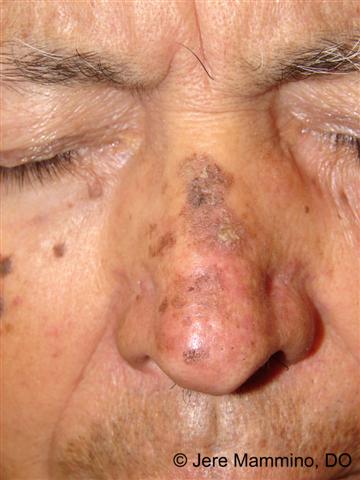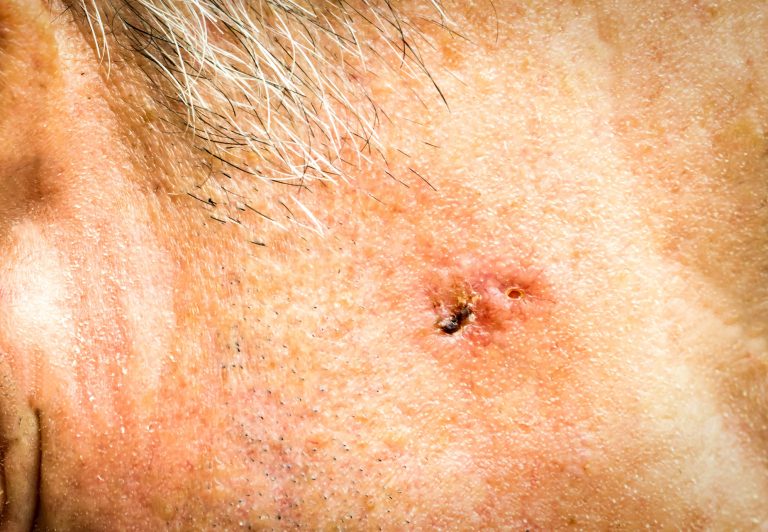Skin Cancer Basics
Skin cancer is the most common type of cancer, with estimates of 1 in 5 Americans developing some form over the course of their lifetime. However, when detected early, skin cancer is highly treatable. Typically, people will notice a mole or other lesion that is new or has changed in size, shape, or color. All of these observations are possible warning signs of cancer. At Goodskin Dermatology, we encourage anyone who has concerns or questions regarding a suspicious lesion to come visit us. We take pride in being skin cancer experts and will use our knowledge, experience, and the best tools to accurately diagnose and effectively treat your condition. Read on below to learn about Risk Factors and Common Types of Skin Cancer.
Common Skin Cancer Risk Factors
Anyone can get skin cancer, regardless of skin color. However, there are certain factors that increase the risk of occurrence. These factors don’t necessarily mean you will get skin cancer, but it’s helpful to understand if you are at higher risk so you can take extra precautions to help avoid skin cancer.
Risk Factors include:
- Age
- Light-Colored Skin
- Skin Prone to Sunburn
- Blond/Red Hair
- Blue/Green Eyes
- More Than 50 Moles
- History of Sunburns
- Use of Tanning Beds
- Received an Organ Transplant
- History of Skin Cancer (Self or Family History)
Actinic Keratoses (AKs)
Actinic keratosis (or solar keratosis) is scaly or dry skin, caused by over-exposure to UV light from the sun or tanning beds. Commonly found on the hands, forearms, face, and scalp, groups of these AKs often start as small, sandpaper-like patches of skin. They can range in color (skin-colored to red-brown) and can grow in size, from almost undetectable to larger than a quarter.
Actinic keratoses are considered to be pre-cancerous spots that, left undetected or untreated, can lead to skin cancer. Having a dermatology provider examine any worrisome dry or scaly patches of skin will help identify any AKs early on. Effective treatment can then be used to prevent the potential progression of skin cancer.



Common Types of Skin Cancer
Basal Cell Carcinoma
Basal Cell Carcinoma (BCC) is the most common form of skin cancer. It typically appears as uncontrolled growths or lesions that perpetuate from normal basal cells in the skin.
BCCs can come in many shapes and sizes. It might appear dome-shaped with visible blood vessels or could be a sore that doesn’t heal. BCCs do not typically spread past the original lesion, but they can cause disfiguration at the site and should be treated promptly.
BCC most commonly appears on skin exposed to a lot of UV light from the sun or tanning beds. The scalp, face, nose, neck, and hands are all high risk areas.


Squamous Cell Carcinoma
Squamous Cell Carcinoma (SCC) is the second most common form of skin cancer and is characterized as a growth of abnormal cells also arising from the skin (similar to BCC).
SCCs can present as bumps that feel crusty or rough, scaly red patches, open sores, or lesions that won’t heal. They can also begin as precancerous growths (AKs). Like BCC, they commonly appear on areas of skin that are frequently exposed to UV light from the sun. Sometimes they can develop on areas of the body that do not get sun, like inside the mouth or on the genitals.
It’s important to note that SCCs should be treated promptly because they can spread to other areas of the body, making treatment more difficult. Left untreated, they can be disfiguring at the site of the lesion, and in some cases, can be deadly.
Melanoma
Melanoma is the most dangerous form of skin cancer, affecting the pigment-producing cells in the skin (melanocytes). Mutations to these cells cause them to rapidly reproduce as a malignant (cancerous) tumor. This is typically caused by over-exposure to UV light from the sun or tanning beds, but melanomas can occur on other areas of the body not commonly exposed to the sun. In addition, a family history of melanoma increases your risk of developing the disease.
Melanoma often resembles a mole on your skin. However, there are certain things to pay attention to to help distinguish a harmless spot from melanoma. Healthy moles typically are symmetrical in shape, have well-defined borders, and are all one color. Pay attention to any moles that don’t follow those guidelines or are changing rapidly in color, size, or shape. You will definitely want to have a provider check those particular moles for melanoma.

If caught early and treated, melanoma is almost always curable. If not diagnosed early enough, it can spread (metastasis) to other parts of the body, making treatment much harder and it can be fatal. Be sure to schedule an appointment with a provider if you are suspicious of any lesions on your skin.
A Special Note for People With Skin of Color
Although occurring much less frequently in skin of color, skin cancer can happen to anyone. Because it is much harder to detect in skin of color, it is often diagnosed at a more advanced stage, which can make treatment more difficult. For people of color, skin cancer is often found in areas of the body that are not typically exposed to UV light. Common areas of diagnosis include the palms of the hand, soles of the feet, fingernails and toenails, inside your mouth, and your groin and buttocks. Be sure to pay special attention to these areas when examining your skin for any suspicious moles or lesions.


